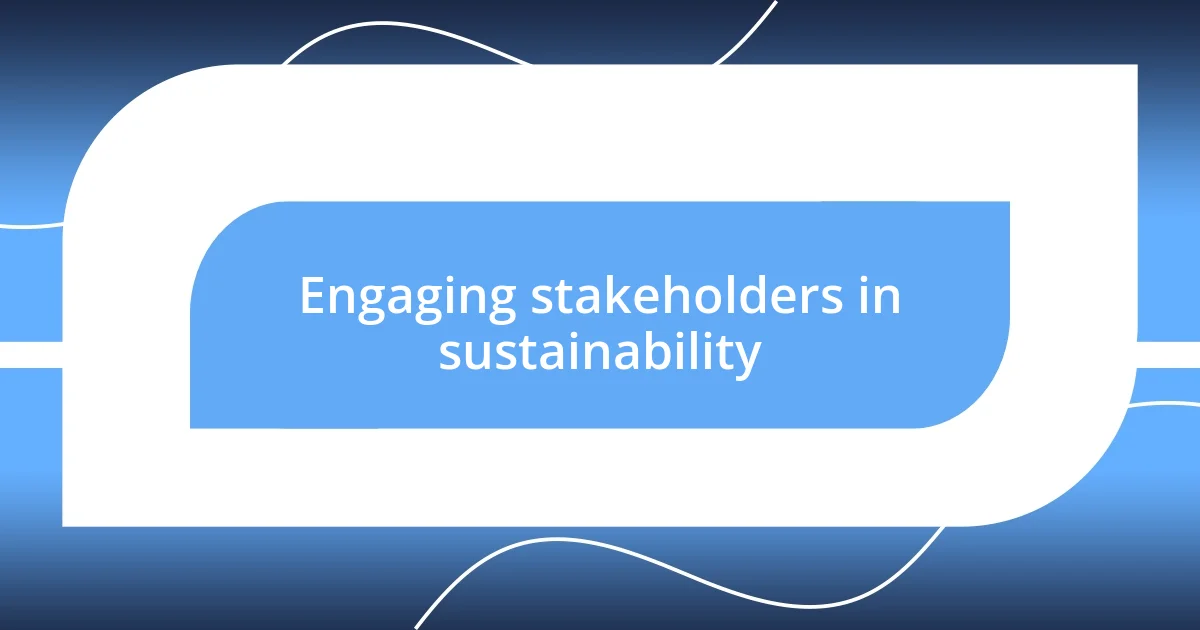Key takeaways:
- Sustainability in business involves integrating social, economic, and environmental factors to create long-term value without compromising future resources.
- Engaging stakeholders, including employees and suppliers, fosters innovation and builds a collaborative approach to sustainable practices and initiatives.
- Measuring success through clear KPIs and sharing achievements via storytelling and visual data enhances motivation and reinforces commitment to sustainability goals.

Understanding sustainability in business
Sustainability in business is more than just a buzzword; it’s a way of thinking and operating that acknowledges the interconnectedness of our planet and economy. I remember the first time I grasped this concept—it was during a workshop on corporate responsibility. The facilitator asked, “How can your business create value without compromising the future?” That question lingered in my mind, pushing me to re-evaluate my company’s practices.
It’s easy to get caught in the daily grind, focusing solely on profit margins. However, I learned that integrating sustainability often leads to innovative solutions that benefit not just the environment but also the bottom line. For instance, when we shifted to eco-friendly packaging, not only did we reduce waste, but we also gained recognition from customers who resonated with our values. This experience made me realize that sustainability isn’t just about doing good; it’s also a powerful business strategy.
Understanding sustainability means embracing a holistic view of operations—considering social, economic, and environmental factors together. It challenges us to think about the long-term impacts of our decisions. Have you ever thought about the legacy your company will leave behind? This perspective change can be profound; it shifts from a short-term focus to a mindset that prioritizes future generations while still achieving today’s goals.

Identifying sustainable practices
Identifying sustainable practices begins with assessing current operations and pinpointing areas where changes can be made. I did a thorough audit of my business processes and discovered simple yet effective steps that could reduce our ecological footprint. For instance, our energy consumption habits changed dramatically when we switched to energy-efficient appliances; I noticed not only a decrease in our utility bills but also an uplift in staff morale as they felt more involved in our sustainability journey.
A great way to identify sustainable practices is by involving employees in the conversation. I remember hosting a brainstorming session where every team member could share their ideas on sustainability. The enthusiasm was contagious! It’s fascinating how fresh perspectives from various departments can uncover innovative solutions that benefit the environment. One suggestion led to a recycling program that not only decluttered our workspaces but also educated our team about waste reduction—creating a more eco-conscious workplace overall.
Additionally, staying informed about industry trends and new sustainable technologies can make a significant difference. I subscribe to sustainability journals and attend webinars to keep my knowledge fresh. By doing this, I can implement practices that are not just sustainable but also relevant to my industry. For instance, I recently adopted a digital-first approach that minimized paper use in our marketing campaigns. This not only enhanced our sustainability efforts but also streamlined our workflows, proving that sustainability can often go hand-in-hand with efficiency.
| Sustainable Practice | Benefit |
|---|---|
| Energy-efficient appliances | Lowered utility bills, improved staff morale |
| Employee brainstorming sessions | Fostered innovation and increased awareness |
| Digital-first marketing | Reduced paper use and streamlined processes |

Assessing your business impact
Assessing the impact of your business might initially feel daunting, but it’s a crucial step in embracing sustainability. I remember when I first conducted an impact assessment for my company; it was like peeling back layers of an onion, revealing areas for improvement I hadn’t previously considered. This experience not only highlighted our carbon footprint but also helped us realize our social impacts, such as employee well-being and community engagement.
To help you get started, consider these key areas for assessment:
- Carbon footprint: Measure greenhouse gas emissions from operations.
- Resource usage: Analyze water, energy, and raw material consumption.
- Waste management: Evaluate how waste is generated and disposed of.
- Social impact: Assess employee satisfaction and community involvement.
- Supply chain practices: Look at the sustainability of suppliers and logistics.
Taking the time to delve into these areas can reveal surprising insights. For instance, when I began tracking our energy usage, I was shocked to find our manufacturing facility consumed far more energy than projected. This pushed me to invest in renewable energy sources, ultimately saving costs and enhancing our green credentials. The revelation transformed not only our operations but also fortified our commitment to sustainability.

Developing a sustainability plan
Developing a sustainability plan is like charting a course for a journey. You need a clear vision of where you want to go. When I set out to create my own sustainability roadmap, I reflected on our core values and how we wanted to align our operations with them. A vivid example was committing to sourcing materials locally. This not only minimized transportation emissions but also supported local economies. It was empowering to witness the ripple effect of our decisions.
I found that breaking the plan down into achievable milestones made the process more manageable. Instead of viewing sustainability as an overwhelming goal, I created quarterly targets for reducing waste and enhancing energy efficiency. Each time we achieved a milestone, it felt like a mini-celebration—an encouragement to keep the momentum going. After all, what’s the use of an ambitious plan if it doesn’t ignite excitement among the team? I still remember the energy in our office when we surpassed our waste reduction target. Those moments are what make sustainability real and motivating.
Collaboration was crucial in shaping our sustainability plan. I initiated cross-departmental meetings where insights flowed freely, leading to unexpected innovations. The most memorable moment was when our marketing team suggested a green event to promote our sustainable initiatives, which not only engaged our community but also fostered internal camaraderie. Have you thought about how cooperation within your team can lead to groundbreaking ideas? It’s amazing how shared values can turn sustainable goals into collective victories.

Engaging stakeholders in sustainability
Engaging stakeholders in sustainability is not just a nice-to-have; it’s a necessity. I remember sitting down with our investors, sharing our sustainability vision, and the palpable shift in energy when they saw how committed we were. Their excitement became a crucial driving force in our efforts, proving that when stakeholders feel included, they’re much more likely to support innovative ideas.
One memorable experience was hosting an open forum with employees, where everyone could voice their thoughts and suggestions about our green initiatives. It was eye-opening to hear diverse perspectives, but what struck me the most was the underlying passion that emerged. You could feel the enthusiasm in the room! These discussions not only fostered a sense of ownership among the team but also sparked new initiatives that had previously gone unexplored. Have you considered how involving your team in these conversations could lead to unexpected solutions?
Moreover, I made it a priority to keep our suppliers in the loop, inviting them into our sustainability journey. During one of our sustainability workshops, we brainstormed ways to lower packaging waste together. The ideas flowed, and by the end, we had not only found solutions but also strengthened our relationships. It’s fascinating how collaboration can turn standard supplier relationships into strategic partnerships, all while advancing sustainable goals. That’s the kind of synergy that makes progress feel less like a chore and more like a shared adventure.

Measuring sustainability success
Measuring sustainability success can often feel like a daunting task, but I’ve found that setting clear, measurable KPIs (Key Performance Indicators) makes the process more straightforward. For instance, I remember when we focused on reducing water usage; we tracked every drop, which made it much easier to see our progress. There’s something deeply satisfying about watching those numbers shift in a positive direction—it instantly fuels motivation within the team. Have you ever measured something that seemed small but had a profound impact on your goals?
A particularly vivid moment for me was when we conducted our annual sustainability audit. I gathered my team to review our results, and there was genuine excitement in the room. We had not only met our energy reduction target but exceeded it by 15%. The pride we felt was palpable, transforming what could have been a mere report into a celebration of our collective efforts. It reinforced my belief that tracking progress not only provides tangible evidence of success but also nurtures a sense of community. How do you celebrate your wins?
In my experience, customer feedback also plays a crucial role in gauging sustainability success. I often review testimonials and social media comments to understand how our eco-friendly initiatives resonate with our customers. One positive message that stood out was from a loyal customer who expressed gratitude for our commitment to sustainable packaging. It reminded me that success isn’t just about numbers; it’s also about the emotional connection we forge with our audience. So, how do you gather feedback to ensure your sustainability efforts are making the right impact?

Sharing sustainability achievements
When it comes to sharing sustainability achievements, I’ve found that storytelling is incredibly powerful. Reflecting on a particular event where I presented our sustainability milestones to the entire company, I could see eyes light up as they connected the dots between their daily efforts and our bigger goals. This wasn’t just a report; it was a celebration of our collective journey, showcasing how each small action contributed to something greater. Have you ever thought about how a good story could enhance the significance of your sustainability efforts?
Another aspect that has made a difference for me is using visual data to highlight our accomplishments. I remember creating an infographic that illustrated our year-on-year carbon footprint reduction—it was like the magic of numbers came alive! When shared with the team, it transformed our achievements into a tangible reality. People weren’t just hearing about changes; they were seeing them laid out vividly. This visual approach not only sparked motivation but also encouraged conversations about where we could go next. How do you visually represent your successes to make them more impactful?
I’ve also realized the importance of recognizing individuals who contribute to sustainability efforts. During a team meeting, I took a moment to spotlight an employee who had spearheaded an innovative recycling initiative. The applause that erupted wasn’t just for the initiative; it was a celebration of dedication and creativity. Acknowledging these efforts not only boosts morale but also inspires others to step up. Have you considered how much a simple recognition can fuel a culture of sustainability in your organization?














